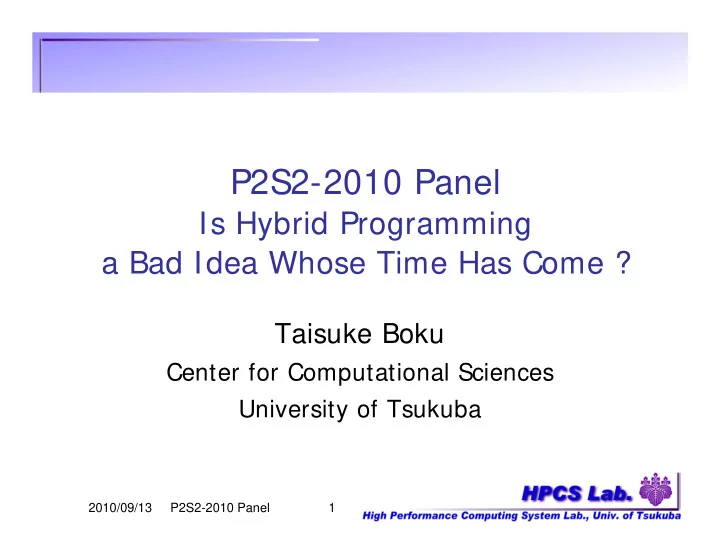

P2S2-2010 Panel Is Hybrid Programming a Bad Idea Whose Time Has Come ? Taisuke Boku Center for Computational Sciences University of Tsukuba 2010/09/13 P2S2-2010 Panel 1
Definition Term of “Hybrid Programming” sometime means “Hybrid Memory Programming” such as a combination of shared- memory and distributed-memory: ex) MPI + OpenMP Term of “Heterogeneous Programming” sometime means “Hybrid Programming over Heterogeneous CPU Architecture” such as a combination of general purpose CPU and special purpose accelerator: ex) C + CUDA In this panel, “Hybrid Programming” includes both meaning 2010/09/13 P2S2-2010 Panel 2
Has the time of Hybrid Programming come ? Today’s most typical hybrid architecture is “multi-core general CPU + (multiple) GPU”, and on this architecture, we are doing hybrid programming such as C + CUDA, everyday Up to 10+ PFLOPS, it is OK to provide the performance with general-purpose CPU only (ex. Japan’s “KEI” Computer, Sequoia or Blue Water), but beyond, it will be quite harder To prepare the upcoming days of 100 PFLOPS to 1 EFLOPS, we have to prepare because productive application programming requires a couple of years at least 2010/09/13 P2S2-2010 Panel 3
Is it a good or thing to be accepted ? We have not been released yet from the curse of hybrid memory programming: MPI + OpenMP is the most efficient way for current multi-core + multi-socket node architecture with interconnection network Regardless of the programmer’s pain, we are forced to do it, and we need a strong model, language and tools to release these pains Issues to be considered Memory hybridness (shared and distributed) CPU hybridness (general and accelerator) “flat” model is not a solution – we need to exploit the goodness of all these architecture as well as hybrid programming does 2010/09/13 P2S2-2010 Panel 4
Necessity of overcoming memory hybridness Many of today’s parallel applications are still not ready for memory hybridness - many of them are written only with MPI For really many cores such as 1M cores, it is impossible to continue MP-only programming Increased cost for collective communication at lease with log(P) order Memory footprint cost to manage huge number of processes is not negligible while memory capacity per core is reducing It is relatively easy to apply automatic parallelization on hybrid memory architecture because such a huge parallelism must include multiple level of nested loops Multi-level loop decomposition into memory hierarchy (and network hierarchy perhaps) 2010/09/13 P2S2-2010 Panel 5
An example of effort Hybridness of CPU/GPU memory on a computation node GPU is currently attached to CPU as a peripheral device as an I/O device with communication over PCI-E bus It causes distributed memory (different address space) structure even on a single node “Message Passing” in a node must be performed additionally to that among multiple nodes XcalableMP (XMP) programming language Programming of large and multiple data array distributed over multiple computation node to be translated as local index access and message passing (similar to HPF) Both “global view” (for easy access to a unified data image) and “local view” (for performance tuning) are provided and unified Data movement in global view makes the data transfer among nodes as like as simple data assignment 2010/09/13 P2S2-2010 Panel 6
gmove directive The "gmove" construct copies data of distributed arrays in global-view. When no option is specified, the copy operation is performed collectively by all nodes in the executing node set. If an "in" or "out" clause is specified, the copy operation should be done by one-side communication ("get" and "put") for remote memory access. A B !$xmp nodes p(*) !$xmp template t(N) n n n n n n n n !$xmp distributed t(block) to p o o o o o o o o real A(N,N),B(N,N),C(N,N) d d d d d d d d Easy data movement e e e e e e e e !$xmp align A(i,*), B(i,*),C(*,i) with t(i) among CPU/GPU 1 2 3 4 1 2 3 4 address space A(1) = B(20) // it may cause error C !$xmp gmove A(1:N-2,:) = B(2:N-1,:) // shift operation node1 !$xmp gmove C(:,:) = A(:,:) // all-to-all node2 !$xmp gmove out node3 X(1:10) = B(1:10,1) // done by put operaiton node4 2010/09/13 P2S2-2010 Panel 7
CPU/GPU coordination data management CPU CPU cores memory GPU GPU cores Message Passing memory (MPI) Array data Loop execution • data distribution distribution process assignment • process assignment CPU • message passing CPU cores PCI-E • CPU/GPU data copy memory driver (CUDA data copy) All in the directive based GPU GPU cores sequential (-like) code memory by XMP/GPU Computation Node 2010/09/06 FP3C Kickoff 8 Meeting (Paris)
XMP/GPU image (dispatch to GPU) # pragma xmp nodes p(* ) // node declaration # pragma xmp nodes gpu g(* ) // GPU node declaration … # pragma xmp distribute AP() onto p(* ) // data distribution # pragma xmp distribute AG() onto g(* ) # pragma xmp align G[i] with AG[i] // data alignment # pragma amp align P[i] with AP[i] int main(void) { … // data movement by gmove (CPU ⇒ GPU) # pragma xmp gmove AG[:] = AP[:]; # pragma xmp loop on AG(i) for(i= 0; …) // computatio on GPU (passed to CUDA compiler) AG[i] = ... // data movement by gmove (GPU ⇒ CPU) # pragma xmp gmove AP[:] = AG[:]; 2010/09/06 FP3C Kickoff 9 Meeting (Paris)
What we need ? Unified easy programming language and tools with additional performance tuning feature is required At the first step of programming, easy import from sequential or traditionally parallel code is important Directive-base additional feature is useful to keep the basic construct of the language as well as the room of performance tuning How to specify a reasonable and effective standard directive to be applied for many of heterogeneous architectures ? 2010/09/13 P2S2-2010 Panel 10
Recommend
More recommend